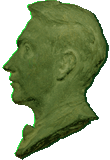
The Scientific Counsil of the Intitute for Nuclear Research of the Russian Academy of Sciences awarded Markov Prize in 2011 for great contribution to theoretical and experimental investigations in the field of elementary particle physics, nuclear physics and neutrino astrophysics to
Alexey KUREPIN, doctor in physics and mathematics, head of laboratory of mesonuclear interactions,
for great contribution to researches in the field of relativistic nuclear physics and discovery of new properties of nuclei and nuclear matter,
Igor ZHELEZNYKH, PhD in physics and mathematics, the head of laboratory of new methods for detecting neutrinos and other elementary particles,
for proposals and developments of new methods for detecting neutrinos and other elementary particles, and
Aston KOMAR, doctor in physics and mathematics, the head of laboratory in the Lebedev Physical Institute,
for great contribution to theoretical and experimental studies in elementary particle physics
Alexey KUREPIN is a world famous specialist in the field of physics of few-nucleons systems, nuclear reactions with intermediate energy particles, properties of non-spherical nuclei, pion-nuclear interactions, relativistic nuclei collisions. He is the author of pioneer works on research of interactions of protons and tritium which led to discovery of a new high-excitation state of a He-4 nucleus.He proposed and developed a new comparative method for investigating nuclear reactions with heavy non-spherical nuclei and resonance reactions with a proton spin change. A resonance anomaly in the cross-section of pi-mesons production in a proton beam has been discovered and a model of this phenomenon has been elaborated as a manifestation of isobar excitations in nuclear matter.He was the leader of the first physical experiment on proton beam of the Moscow Meson Factory accelerator which confirmed the existence of the anomaly.Under his supervision installations PLASMAS in INR and CASPY in JINR have been created, detectors have been manufactured and nowadays researches are under way at large nuclear-physical setups ALICE, CMS, SPS in CERN, HADES and CBM in Germany, Nuclotron in Dubna and others, some new phenomena have been discovered during collisions of relativistic ions with nuclei, some indications of origin of a new state of nuclear matter have been obtained.
Igor ZHELEZNYKH is well known by his great scientific results in the field f neutrino physics and astrophysics of high and superhigh energies. At the beginning of the 1960ths, in collaboration with M.A.Markov, he proposed to construct large-scaled underground detectors of high energy cosmic neutrinos and put forward the idea to search for neutrinos from “point-like” astrophysical objects (neutrino astronomy). He made the first calculations of cross-sections of neutrino interaction with nucleons, electrons and nuclei in a wide range of energy from 10
9 up to 10
24 eV, and calculated energy spectra and angular distributions of high energy atmospheric neutrinos.In 1965 in conjunction with M.A.Markov he proposed some experiments on detecting neutral and charged intermediate bosons in resonance antiproton-proton and antiproton-neutron reactions.For the first time he considered the problem of the existence of Dirac relic magnetic monopoles in 1969 along with G.V. Domogatsky in the framework of the “hot” Universe model. In the 1970-80ths he took an active part in elaborating the optical and acoustic methods of deep underwater detection of cosmic neutrinos and other elementary particles of superhigh energies in the world ocean (project DUMAND) and in creating the optical neutrino telescope NESTOR and acoustic neutrino telescope SADKO in the Mediterranean sea. In cooperation with G.A.Gusev he proposed a radiowave Antarctic muon and neutrino detector (RAMAND) for recording Cherenkov radioemission of cascades produced by neutrinos with energies more than 10
14 eV in the large ice area of Antarctic Continent. Zheleznykh and R.D. Dagkesamansky were the first to put forward the idea to use large operating radiotelescopes to detect radioemission of electron-photon and hadron cascades which arise during interaction of neutrinos and other particles of superhigh energies (>10
20 eV) with the Moon and other space objects. From the beginning of the century he has been organizing the elaboration of coordinate-sensitive scintillation detectors of gamma-quanta, neutrons and charged particles on the base of multiplex avalanche photodiodes.
Aston KOMAR is a well known specialist in the field of elementary particle physics. He was the first to make detailed calculations of the values of cross-sections of the main electrodynamic processes for particles with spin 3/2, he determined rigid limits on the possibility to use different versions of non-local field theories, showed that it’s impossible to create a renormalized Yang-Mills theory of massive fields even with a global symmetry of lagrangian, made pioneer works on the usage of theoretical-group methods in the particle physics which led, in particular, to understanding the nature of newly discovered elementary psi-particles on the basis of heavy c-quarks. He proposed to use the nuclear photoemulsions method to search for charmed particles and to use antiproton beams to study bound states of these particles. The idea was realized in CERN and Fermilab (USA).Since 1978 he has been the head of the high energy electrons laboratory in Lebedev’s Institute of RAS where important works on luminescence of wide zone crystals were carried out (a phenomenon of cross-luminescence was discovered) and some units for the liquid argon hadron calorimeter ATLAS LHC were manufactured.
PRIZE REGULATIONS

DIPLOMA and MEDAL
 Medal Scetch on the Base of the Moisey Markov Bas-relief which was made from Life in 1957 by Sculptor Olga Domogatskaya |  Markov Prize Laureate Medal was made for the 100th Anniversary of Academician Markov |
 LAUREATES of the
LAUREATES of the


